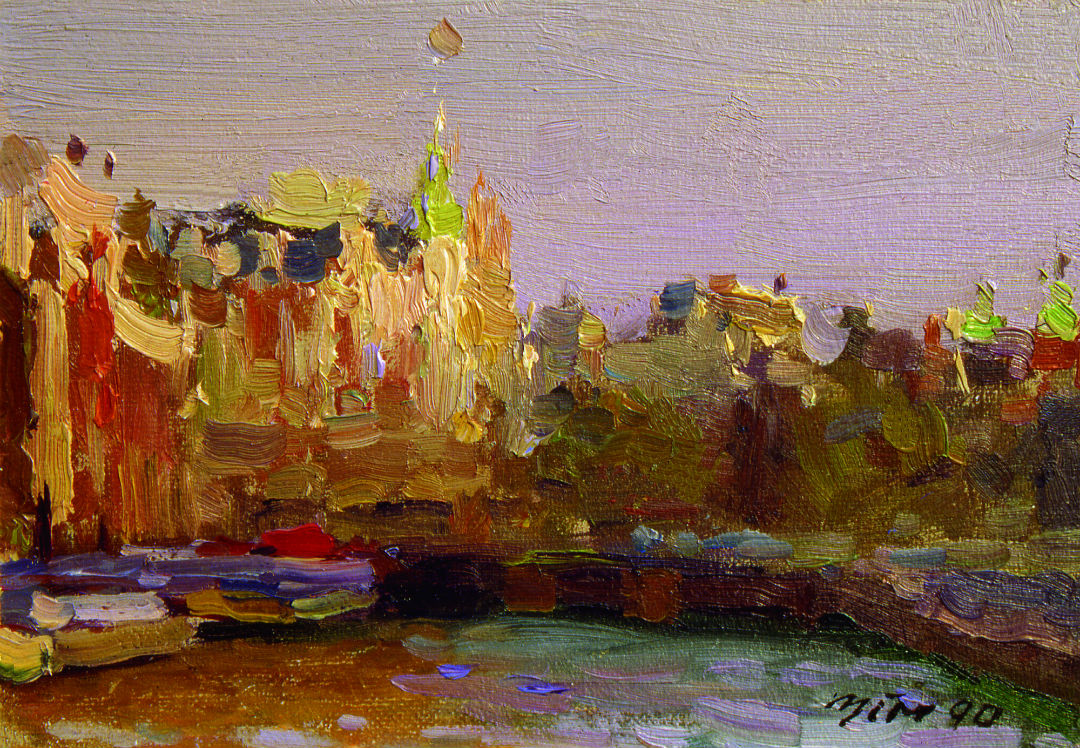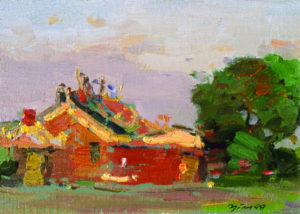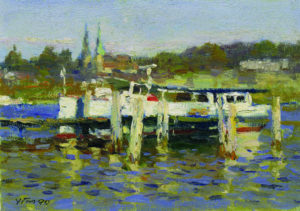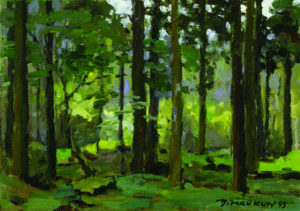Liang Qi-qi, my class director back in high school, had an extremely good feel for color. He was sent to the countryside as a teacher during the Cultural Revolution and worked at the Yangchun County Cultural Center in Guangdong, China, before returning to the art institute. He had painted many exceptional small landscapes at the time and when I visited him while passing through Yangchun, he laid them out for me one by one in his tiny studio. His confident smile and pleasure at the time left a strong impression on me
Small plein-air paintings offer only a limited amount of space and time to work with so it forces us to explore the relationship between the major color relationships. It is therefore very effective for training “color use” and force us to see the forest, not the trees.
Just how big is 5 x 7 inches? It’s just about the size of my palm. Balancing all kinds of changing scenery and managing the different spaces in such a small surface area is a unique challenge that requires its own special techniques. It took many years of painting before I began to discover some of the principles and methods
Composition
To begin with, avoid small and intricate objects when deciding on the scenery and layout such as twigs, vines, wires and window lattices. For lawns, vegetable patches and bushes you must simplify the brush strokes and turn them into blocks of color. When the scenery is translated into blocks of colors that vary in their color temperature and value, the painting becomes more interesting and the experience becomes more rewarding for the painter. If you aren’t prepared to simplify the complex and try to put every little detail you see on canvas, you will ruin the small painting and end up with a mess of broken elements.
Levitan believed that in landscape paintings the mission could be summed up as dealing with the relationship between the sky, ground and water. This is important wisdom from masters before us. For the first step, you indeed have to separate the sky, earth and water in terms of how bright the color blocks are and the colors used. If you have the relationship right, the general layout for a small painting emerges. This was what the Russian School introduced. When the “gray tone” is added, it achieves very effective results. Back in the 1950s it quickly spread among the art institutes and added new vocabulary to Chinese oil paintings.
Space is the soul of the landscape painting.
Beyond space and perspective, mini-landscape paintings also have to clearly express through colors the relationship between the sky, ground and water. Otherwise you end up with merely large blocks of color not much better than two-dimensional industrial design where the colors block the way like walls in the picture. Without the right foundation of color blocks, it’s futile to build on it more color structures. There will be a lack of sense of space, let alone sense of artistic atmosphere. This is why I place great emphasis on the perspective and spatial relationships in the image to make the painting come “through.”
Lake Luzerne (Luzerne, Switzerland) 4.7 x 6.7 inches
Brushwork
The brushwork gives landscape paintings their charm and this is particularly true for small paintings.
On a basic level, it “translates” the scenery that we see into impressions of different color blocks. The next step is naturally using brushwork to express these color blocks. While thick and broad strokes can be quite effective, if these are not balanced by subtle gradients of color then the bold strokes become primitive and simplistic. While small paintings are usually done quickly, in my experience taking too little time easily led to them appearing vapid. I usually allow for forty to fifty minutes, giving me time to go back over the tones and color blocks or give the key points or details some extra attention. I try to make the small paintings more than painting exercises or records of large color blocks so they could have more of their own artistic merit.
Process
Generally I start by using the cyans. Sometimes I use the browns to “touch up” the dark parts. I don’t usually use oil for the block-in nor for mixing colors when blocking in. The oil would blur the image easily, leading to faulty or dirty colors.
With small canvases I like to prime the canvas with light gray-green, gray-ochre or gray-violet. Having an intermediate tone made it easier to manage the harmony of the elements in the image. A surface with a base coat also had a particularly good “feel” for the brush though for bright scenes it might appear a little dull. Sometimes I use a completely white base to achieve a vivid result the first time round. Serov for example liked to use a white canvas and he had an amazing talent for getting the colors right the first time. For mini-landscape paintings, I prefer to use a larger boar bristle for blocking-in and a small mink brush for finishing up and detailing. If I spend more than an hour on a small painting, it’s probably overdone – either too much detailing or the paints had “congealed.”
In summary, plein-air landscaping is a process where natural (objective) beauty is fused with artistic (subjective) beauty. Natural beauty emphasizes the “feel” while artistic beauty focuses on the “appeal,” or in plainer terms, “fun.” If you become fixated on pursuing realistic details, painting becomes a chore rather than pleasure. Conversely, if the brushwork and colors depart too much from the natural scenery, the scenery itself falls apart and loses its feel. What’s left are scribbles of brush and ink bearing no resemblance to the essence of plein-air painting.
For me, the mini-landscape painting is the best and most pleasant way to converse with nature. I have always loved small paintings and my heart has remained true for all these decades. Such is the magic of small oil paintings!






Great!! I realize the merit of small painting
I love small paintings and that is the bulk of my work. While I was encouraged to go larger, after seeing Sorolla’s works and MauKim’s, I decided to stay true to my love. There is something so fresh in these small gems and much value in being able to test ideas that perhaps will translate to larger works. Thanks so much for these gems of wisdom! I really appreciate it!!
Hi, Elizabeth, we’re glad you found the blog post helpful 🙂 Both small and large works have their own merits. But small works is more fun because its spontaneity.